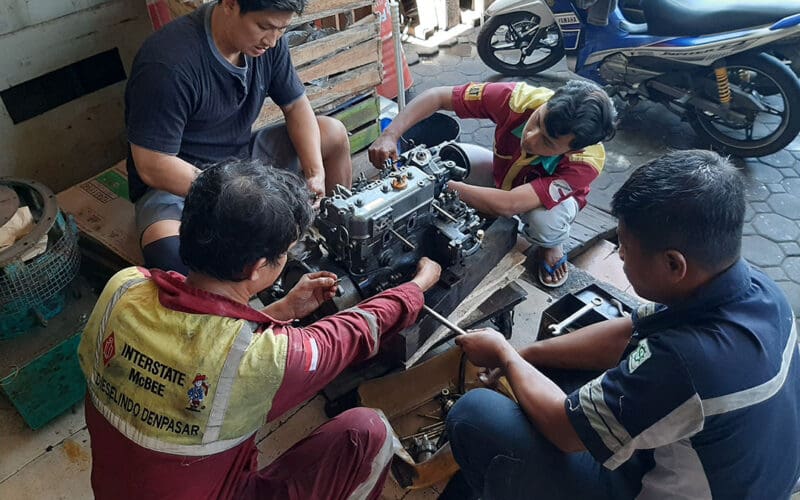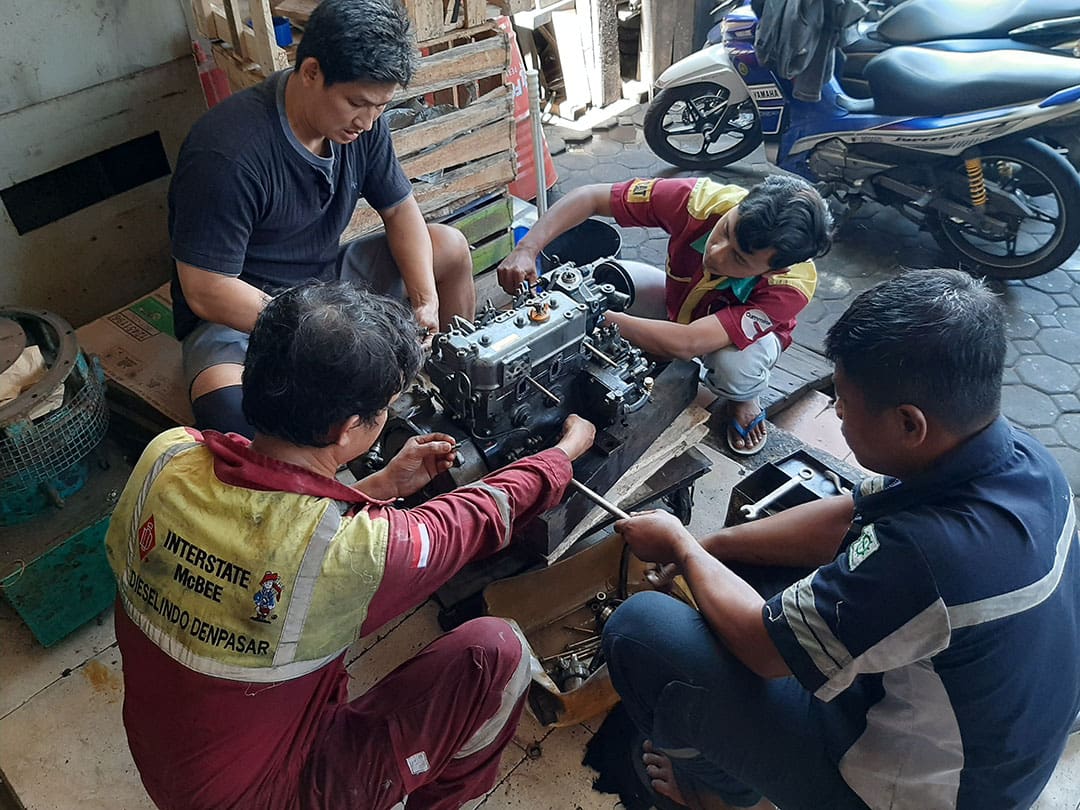
Voyagers need to know their diesel engines and there are plenty of ways to gain experience in working on them. My most recent experiences involved getting engines rebuilt while being in Indonesia. The experience was instructive of how to go about the process when in a foreign country.
My first foray into an engine rebuild was almost 50 years ago. I overhauled my 1961 40 horsepower Volkswagen bus gasoline engine using John Muir’s classic book How to Keep Your Volkswagen Alive: A Manual… for the Complete Idiot. What an exercise in engine mechanics that was and the start of my amateur engine repair career. Because the engine was air cooled and had a habit of dropping valves, it was also worthwhile knowing how to remove and replace the engine on the road. So later, just to be safe, we carried a spare engine on a cross country move in our old VW bus!
Twenty five years later, after purchasing my first ocean-capable cruising boat, a 1980 CSY 44 Walkthrough with a dying Perkins 4154 marine diesel, I decided to try to overhaul the engine myself. This time it took six months working in my garage to tear it completely down, get outside work done, find the required new or used parts, clean and paint, and then try to remember how all the parts went back together. Luckily the Perkins Overhaul Manual was reasonably well done, I had a diesel savvy friend, and I had a camera and decent tools. But I realized early on that keeping track of all the nuts and bolts was going to be difficult without a good filing system. So I labeled Ziploc bags for each group of fasteners. Somehow, at the end, there were no significant leftovers. What a great learning experience that was!
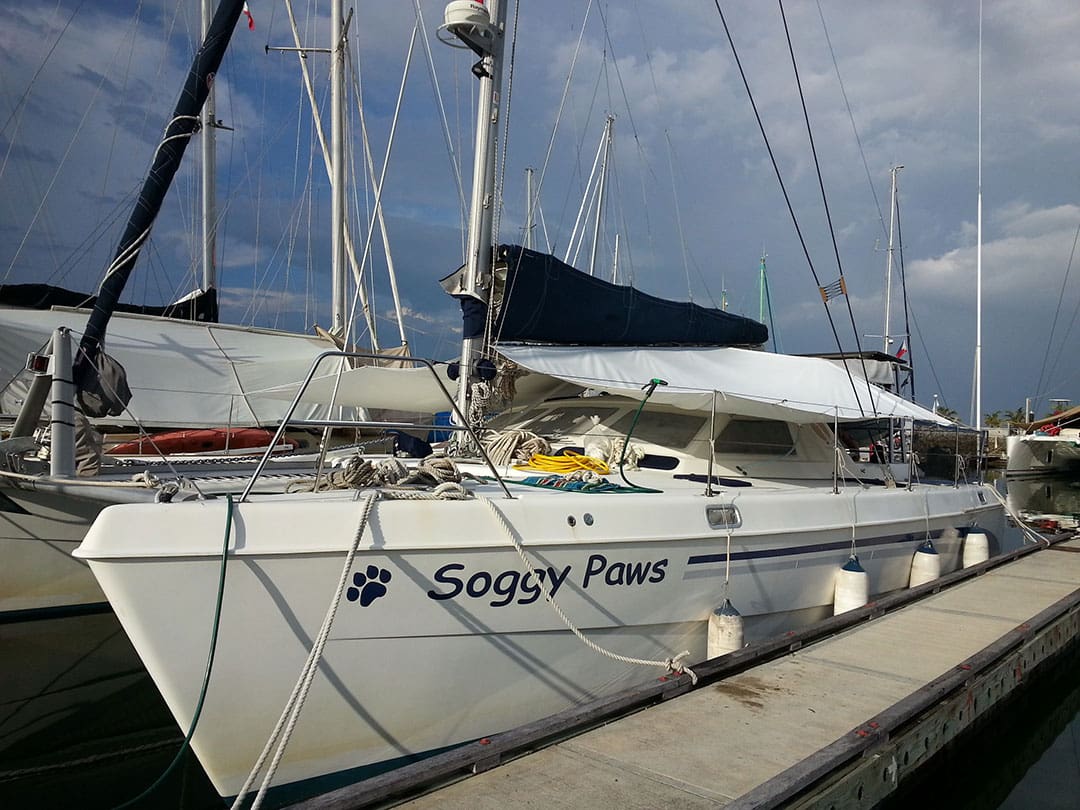
Producing white smoke
Recently, after having spent seven years using the Philippines as a base for cruising in Southeast Asia, we left on our current boat, a St Francis 44 cruising catamaran, and continued our westward journey through southern Indonesia. After about five months while still in West Papua, eastern Indonesia, we realized something was wrong with our starboard Yanmar 3GM30F diesel engine. The injectors and injection pumps had been serviced in Davao before we left, but both engines were now hard to start. Engine experts on the excellent Yanmar Facebook Group said that was indicative of a leak in the fuel supply system. The starboard engine was uncharacteristically producing white smoke after startup, using more fuel than usual and making louder than normal knocking noises while running at slower speeds.
Since we were still on the remote west coast of New Guinea where we had been scuba diving, looking at WWII sites, and generally exploring the coastline, we decided to proceed to Tual in the Kai Islands. The Kais were a small island group 100 nautical miles southwest, where we had been several times previously getting monthly visa extensions.
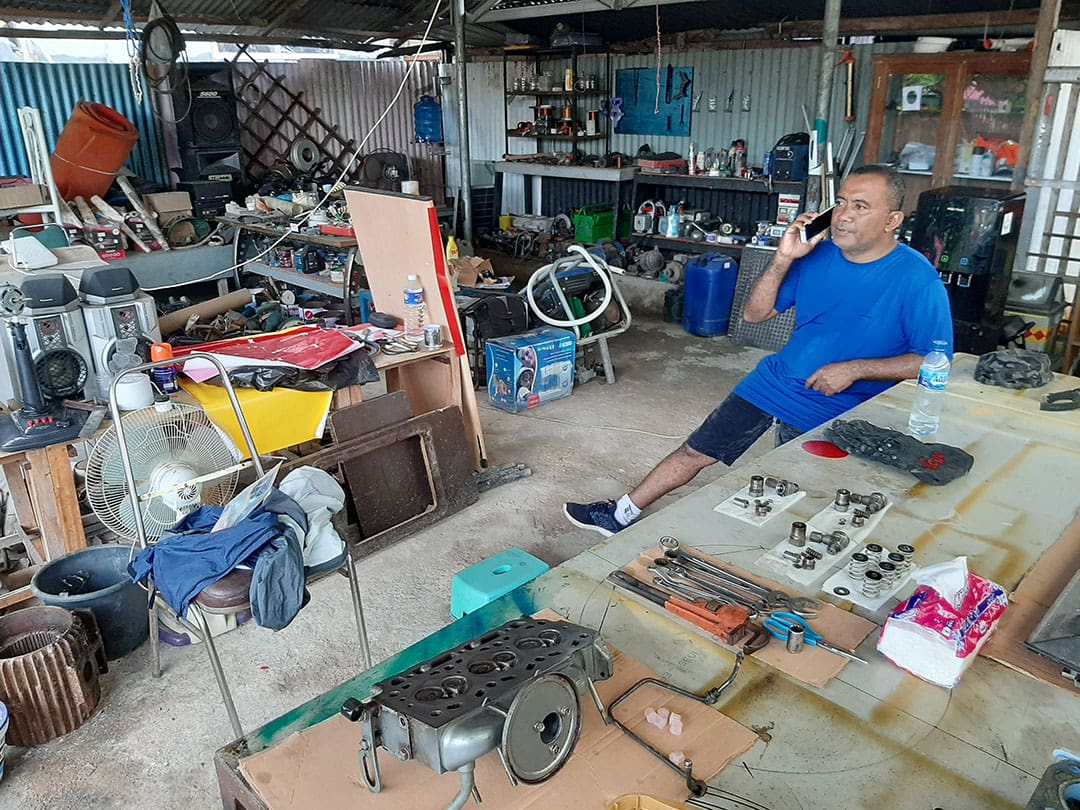 Shortly after arrival, we met our local English-speaking “helper” friend Jhords and his buddy, John, who spoke passable English. John was a self-trained diesel mechanic. Among many other things, he was the go-to mechanic for the entire local diesel-powered fishing boat fleet, the large fish factory, and several schools. He also did all their electrical work, refrigeration and any other mechanical work they needed. In his spare time he bought, sold, rented and repaired motor scooters and bicycles, had a gravestone labeling business, rented large event equipment, and was raising his three kids without a wife to help. Previously he had taught a diesel mechanics course at the local Catholic trade school. And he had a small SUV car, a large cluttered but covered workshop, and a big table with lots of tools. Perfect!
Shortly after arrival, we met our local English-speaking “helper” friend Jhords and his buddy, John, who spoke passable English. John was a self-trained diesel mechanic. Among many other things, he was the go-to mechanic for the entire local diesel-powered fishing boat fleet, the large fish factory, and several schools. He also did all their electrical work, refrigeration and any other mechanical work they needed. In his spare time he bought, sold, rented and repaired motor scooters and bicycles, had a gravestone labeling business, rented large event equipment, and was raising his three kids without a wife to help. Previously he had taught a diesel mechanics course at the local Catholic trade school. And he had a small SUV car, a large cluttered but covered workshop, and a big table with lots of tools. Perfect!
After a good bit of discussion regarding symptoms and what might be wrong, we decided to first do a test start/run and then an injector test. John finally arrived after several missed appointments and we went to work. It took about 10 seconds to finally get the starboard engine to start. John shook his head while watching the white smoke billow out of the exhaust. Then he went to the engine to hear the knocking. Finally, he placed his finger on each of the high pressure lines between the injection pump and injectors to feel the injectors firing and shook his head again at one of them.
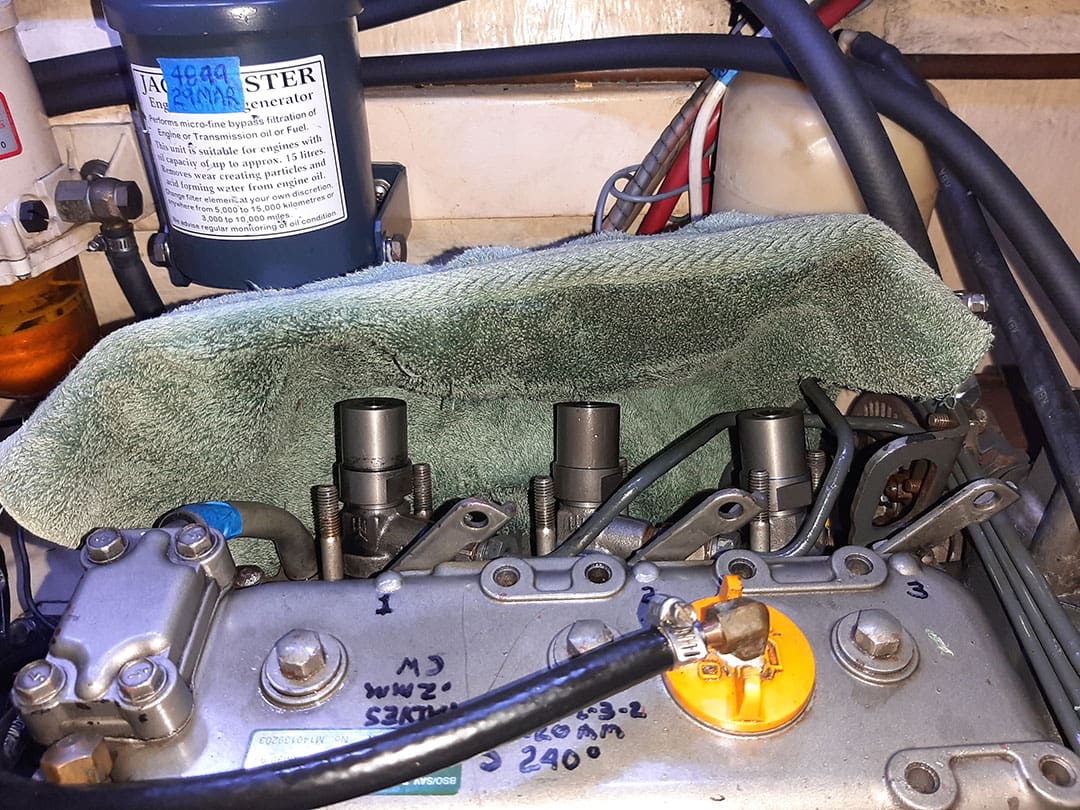
Injector issues
After stopping the engine and some discussion, he took the three injectors out and reconnected them upside down so they would spray up instead of down into the cylinders. We held a towel above them and then engaged the starter. Diesel spray went up into the towel from each injector in turn. We could clearly see that one injector was squirting rather than spraying fuel, and they were all leaking. Also, an assortment of parts came flying out of the injector holes. After finally collecting all the parts, we decided to regroup, clean things up, do a proper cleaning and pop test for the injectors, and make one new heat shield and new copper covers in case we couldn’t get the parts. There was no injection or machine shop in Tual. While John made the parts between other work, I spent some time cleaning injectors, ordering parts and watching Yanmar overhaul videos on the internet.
About a week later I received parts from Dieselindo, a well recommended diesel shop in Bali. Amazingly, the parts came to us air freight for about $5 US in only a couple of days. Now we had all the injector parts we needed plus some spares. Next step was to do a proper injector pop test with the ancient machine at the trade school diesel lab. Although the machine had a pressure gauge it wasn’t reliable, but the part producing the spray pattern was. I had repaired the one injector’s stuck plunger, which had produced the poor spray pattern, and taken them all apart for cleaning. I also was able to clean the various injector hole parts that had come flying out during the onboard injector test. All injectors, including my three spares, now produced a good spray pattern and the pressures all seemed similar.
Back on the boat a couple days later with injectors installed, there was no change to the slow start, smoke and knocking symptoms. So John advised the next step should be to remove the cylinder head and have a look. For this and subsequent work John’s brother, Henkie, a trade school-trained diesel mechanic helped. But he did not speak any English. Now we were getting serious, and I could see this might lead to significant internal engine work. So I was glad to have two developing world mechanics, instead of just one, tearing our engine apart.
After removing the cylinder head, we found multiple problems: leaking valve seats, oil in one of the combustion chambers and what appeared to be a leaking cylinder head gasket, possibly from an earlier overheating episode. Based on that, the knocking and the engine’s 5,000 hours we decided to remove the engine and do a complete overhaul at John’s backyard shed.
Despite my request, John declined to give us a labor quote, saying that he could not estimate the work required until the job was finished and the engine was operating properly. So we kept rough track of his and Henkie’s hours and established a typical Indonesian engine mechanic’s labor rate from the internet. Regardless, we knew the labor cost would be far less than in the US.
Removing the engine
After I spent a day removing some of the auxiliary equipment and cables, wiring and hoses, and separating the engine from the sail drive, the day finally came to take the engine out of the boat. John and his brother were a couple hours late, as usual, but did remember to bring a strong piece of pipe. As planned, we tied the engine’s lifting points to it. Then they lifted the 250-pound engine, mounts and all, off the beds and muscled it up the steps to the cockpit. We rigged the dinghy falls to very carefully move the engine off our boat and on to John’s local fishing skiff. Once ashore, we were able to use the Tual Coast Guard’s cement pier where, with a bit of help, they lifted the engine the six feet out of John’s boat on to the pier and carried it to his car. Then we all went to John’s shed with the engine where it lived for the next month during the overhaul. By late that afternoon most of the engine was in pieces spread around on John’s already cluttered table. Some years ago I had purchased a Yanmar 3GM30 Special Tools kit from a friend, and it really came in handy disassembling and reassembling the engine.
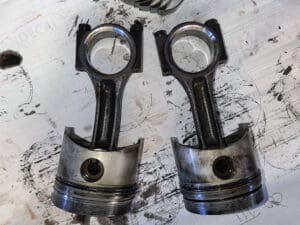
Again we found multiple problems: a bent rod, damaged probably during a cylinder hydro lock event from the leaking cylinder head gasket, one piston rod that was shorter than a new rod by about 2 millimeters, leaking valve seats and seals, worn rings, leaking lip seals, worn shell bearings, and a cracked piston. After additional inspection we decided that since the engine was fully apart now we should replace all the normal wear parts including gaskets, O-rings, shell and roller bearings, piston rings, valve and other seals, most water and fuel hoses, injector covers and fuel and air filters.
No piston check
What we did not check, but probably should have, was the piston and valve stem diameters and a few other things for wear. When overhauling the other diesel at Dieselindo in Bali a month later we needed to replace all three pistons and six valves due to excessive measured wear. Here John just looked to ensure the valves were straight and not damaged and other parts not excessively worn. Then he lapped the valves to their seats so that they no longer leaked with fuel over them. Significant replacement parts included the one cracked piston, two piston rods and the head gasket.
I kept track of needed parts and placed several orders with Dieselindo in Bali. Most parts came quickly, but the piston took several weeks for delivery from Japan via Bali. Finally, we were ready to put the engine back together. Besides installing the new parts, more delays were caused by some additional things that John had to do during the overhaul including:
• Driving me back and forth from the pier to his shop pretty much on a daily basis because he did not trust the local “ojek for hire” motor scooter drivers.
• Covering most parts with oil and clear ‘cling film’ to prevent corrosion while waiting for new parts in the open shop.
• Figuring out which Special Tool was used where.
• Finding an accurate torque wrench and the proper torque reading for each part needing it.
• Finding lost engine parts and tools in John’s shop.
• When necessary buying lunch and riding around with John when he was called away to emergency jobs all over town.
• Finding the tool locally and honing the cylinders so the new rings would seat properly.
• Checking the injection pump timing by watching as the pump pushed fuel into each injector pipe and then marking the crankshaft pulley.
• Completely cleaning and painting the engine.
John’s shop did not have the capability to test run the engine in the shop. So once the engine was back together and painted, we pretty much did the reverse of the removal procedure. John and Henkie did the heavy lifting to get the engine back on the blocks on the boat. I did the finish connections and added oil and coolant. The two hour underway test run went well with no sustained smoke, a much quieter engine and a quick start.
Afterwards we had a typical developing world labor cost discussion. When I asked, he opened with “what do you think it’s worth?” Since we knew roughly the hours they had spent (about 140 hours, over two months’ time including transportation) and the daily Indonesian wage for a contract diesel mechanic, we offered $700 US. That worked out to about $5 an hour. Included in that was a strong recommendation for him from us on our website and elsewhere, which we have done several times since. We were both happy with that. I think he was also happy to get back to his other work.
A month later we arrived in Bali and decided to do the other engine since it had similar hours, and next year we would be crossing the Indian Ocean to the Mediterranean. We used a similar process to remove and reinstall the engine. This time, however, the engine went to a regular Yanmar diesel engine repair shop, Dieselindo, in Denpasar, Bali. By now we were good friends with the manager, Hasta, who had ordered all our parts for the other engine. He had trained mechanics who helped him carefully disassemble the engine, measure all the wear surfaces, send the cylinder head and injection pump to specialists and order needed parts. Then he advised us that the labor for the basic overhaul including removal and reinstallation would be $500 US.
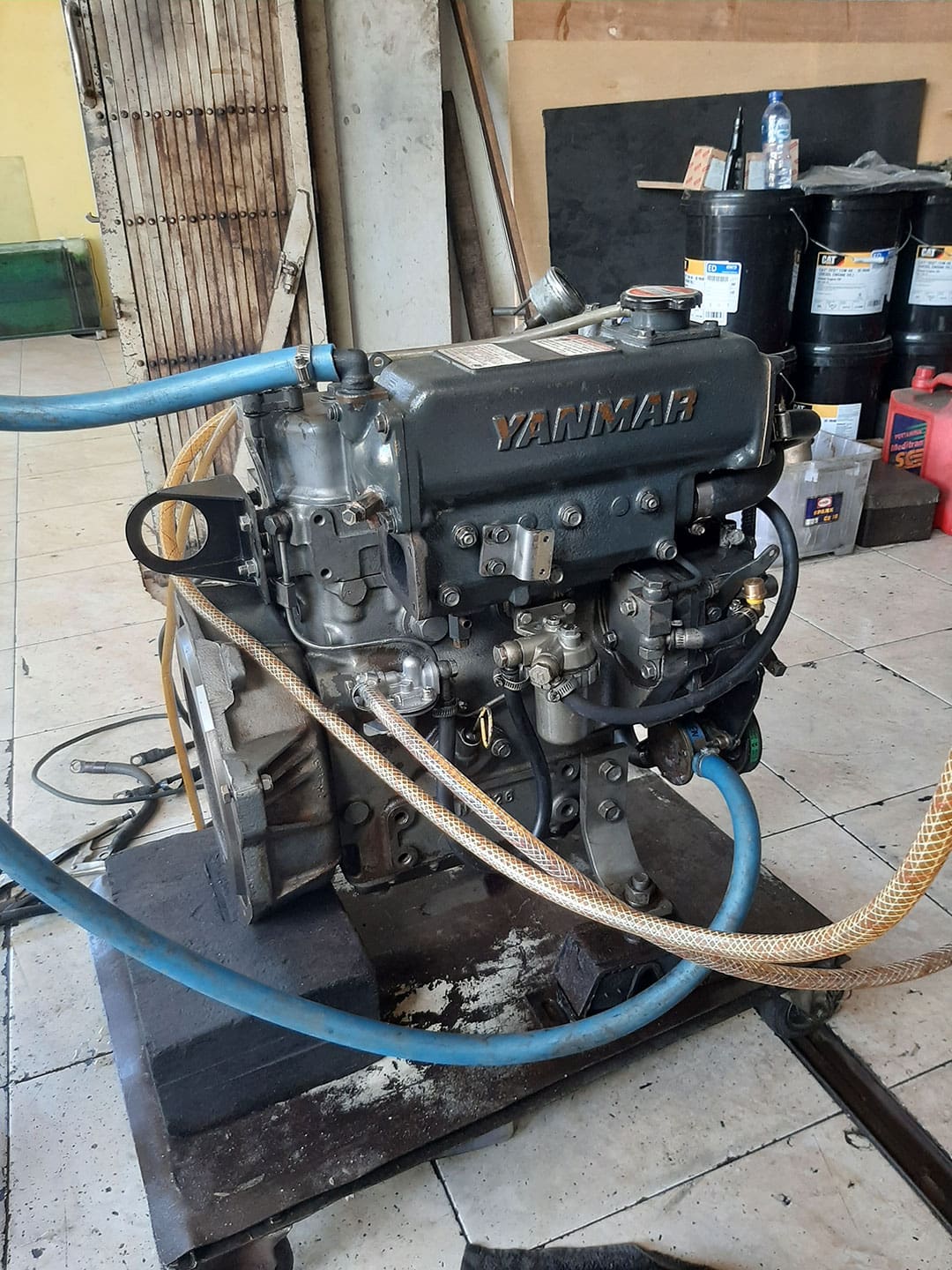
Bench test
Only a week later I was present for the engine bench test at his shop. There had been no major issues other than wear which required replacement parts similar to the starboard engine. Again the injection pump timing test was right on with just the original shims, and there were no significant problems. I also had Hasta add mechanical oil pressure gauges at the engines and recheck all injectors for proper spray and pressure. The engine came back aboard spotlessly clean and freshly painted. This time I let Hasta and his mechanics do the entire installation while I was lazy and watched.
After I added oil and coolant they came back the next day for a successful test run. The run in period for these engines is 50 hours at reduced RPM and then an oil change. After that we were able to use a normal cruising RPM of 75 percent of maximum. Hasta and other professional diesel mechanics on the Yanmar Facebook Group also recommend a five-minute warmup and cool down and running the engine up to maximum RPM for about 10 seconds after every use to reduce soot buildup. This Facebook group is a great resource for us amateur mechanics. I used it a number of times when I had questions early on.
Luckily for us both overhauls went well even though done by very different mechanics and with very different facilities and skills. It always amazes me how developing world technicians can successfully repair complex machinery and devices with little formal training, basic tools and at minimal cost. A cruiser can certainly learn a lot from these folks, however, it is still advisable to study the repair in advance, find a parts source, be involved and ask questions. Also, it is worthwhile to source parts manuals, service manuals, and special tools from your engine manufacturer before you leave. An engine casualty at sea can be a scary thing. Thankfully we have two engines! n
Dave McCampbell is a former US Navy officer who spent most of his time as a diving and salvage officer. He and his wife Sherry voyage on their St. Francis 44 Mark II cat Soggy Paws.

